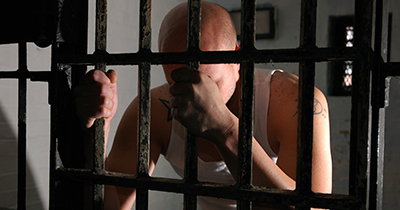HIV Among Incarcerated Populations
Fast Facts
- HIV is a serious health issue for correctional facilities and their incarcerated populations.
- Most incarcerated people with HIV got the virus before entering a correctional facility.
- HIV testing at a correctional facility may be the first time incarcerated people are tested and diagnosed with HIV.
 More than 2 million people in the United States are incarcerated in federal, state, and local correctional facilities on any given day. In 2010, the rate of diagnosed HIV infection among inmates in state and federal prisons was more than five times greater than the rate among people who were not incarcerated. Most inmates with HIV acquire it in their communities, before they are incarcerated.
More than 2 million people in the United States are incarcerated in federal, state, and local correctional facilities on any given day. In 2010, the rate of diagnosed HIV infection among inmates in state and federal prisons was more than five times greater than the rate among people who were not incarcerated. Most inmates with HIV acquire it in their communities, before they are incarcerated.
The Numbers
- In 2012, 1.57 million people were incarcerated in state and federal prisons and at midyear 2013 there were 731,208 people detained in local jails.
- In 2010, there were 20,093 inmates with HIV/AIDS in state and federal prisons with 91% being men.
- Among state and federal jurisdictions reporting in 2010 there were 3,913 inmates living with an AIDS diagnosis.
- Rates of AIDS-related deaths among state and federal prisoners declined an average of 16% per year between 2001 and 2010, from 24 deaths/100,000 in 2001 to 5/100,000 in 2010.
- Among jail populations, African American men are 5 times as likely as white men, and twice as likely as Hispanic/Latino men, to be diagnosed with HIV.
- Among jail populations, African American women are more than twice as likely to be diagnosed with HIV as white or Hispanic/Latino women.
Prevention Challenges
-
 Lack of awareness about HIV and lack of resources for HIV testing and treatment in inmates’ home communities. Most inmates with HIV become infected in their communities, where they may engage in high-risk behaviors or be unaware of available prevention and treatment resources.
Lack of awareness about HIV and lack of resources for HIV testing and treatment in inmates’ home communities. Most inmates with HIV become infected in their communities, where they may engage in high-risk behaviors or be unaware of available prevention and treatment resources. - Lack of resources for HIV testing and treatment in correctional facilities. Prison and jail administrators must weigh the costs of HIV testing and treatment against other needs, and some correctional systems may not provide such services. HIV testing can identify inmates with HIV before they are released. Early diagnosis and treatment can potentially reduce the level of HIV in communities to which inmates return.
- Rapid turnover among jail populations. While most HIV programs in correctional facilities are in prisons, most incarcerated people are detained in jails. Nine out of ten jail inmates are released in under 72 hours, which makes it hard to test them for HIV and help them find treatment.
- Inmate concerns about privacy and fear of stigma. Many inmates do not disclose their high-risk behaviors, such as anal sex or injection drug use, because they fear being stigmatized. Health care providers should keep inmate’s health care information confidential, know the public health confidentiality and reporting laws, and inform inmates about them.
What CDC Is Doing
Funding state, local, and territorial health departments. This is CDC’s largest investment in HIV prevention. CDC funds health departments and community-based organizations (CBOs) to provide HIV prevention services in many settings, including prisons and jails.
- CDC funded selected state health departments to conduct voluntary rapid HIV testing in jails, identify previously undiagnosed cases, and refer inmates to medical care. Of the 33,211 inmates tested, 409 (1.2%) tested positive, and 269 (0.8%) undiagnosed cases of HIV were detected, many among people who had not disclosed their risk behaviors.
Funding community-based pilot projects. CDC has joined with universities, CBOs, and other partners to find out which HIV prevention interventions are most effective among incarcerated populations and how they can be applied to other settings.
- CDC supported Project START, a pre-release HIV intervention for young men. Project participants reduced their HIV risk behaviors after their release back into the community.
- CDC funded the University of North Carolina to evaluate Project POWER, an HIV intervention among women in state correctional facilities. Six months after release, participants reported significantly greater condom use than nonparticipants. Participants also reported greater HIV knowledge, and more social support.
- CDC partnered with Emory University to adapt and evaluate an HIV intervention program for African American girls aged 13-17 in a juvenile detention center. Three months after the intervention, participants reported greater condom use, HIV/STD prevention knowledge, and condom use skills.
- CDC joined with Morehouse Medical School to counsel African American male jail inmates about high-risk sexual behaviors and ways to reduce them. After six months, participants reported significantly more condom use during vaginal or anal sex than nonparticipants. Participants 14-18 years old reported significantly more condom use at last sex with a non-main female sex partner than nonparticipants.
Voluntary rapid HIV testing. CDC partnered with Emory University to support voluntary rapid HIV testing at a large county jail located in a community with a high prevalence of HIV. The jail’s nursing staff provided more than 12,000 tests, and 52 cases of HIV infection were newly diagnosed.
CDC has published HIV testing guidance for correctional facilities which recommends testing inmates when they enter correctional facilities, during incarceration, and just prior to release. CDC also recommends medical treatment and counseling to educate inmates about HIV risk behaviors. HIV prevention education should address male to male sex, tattooing, injection drug use, and other high risk behaviors that occur during and after incarceration.
CDC recommends that condom distribution programs be evaluated for use in prisons and jails in the United States. The World Health Organization recommends such programs as an effective way to reduce HIV among incarcerated populations.
The National Center for HIV/AIDS, Hepatitis, STD and TB Prevention, (NCHHSTP) Corrections Workgroup addresses the prevention and control of HIV, STDs, Viral hepatitis, and TB among incarcerated people. The workgroup includes experts in epidemiology, criminology, and corrections issues, and works to reduce health disparities among incarcerated populations.
CDC scientists edited a special issue of the journal Women & Health, “Infectious and Other Disease Morbidity and Health Equity among Incarcerated Adolescent and Adult Women,” in November 2014, which focused on the health challenges, including HIV, faced by incarcerated women.
1Jails are short-term facilities that are usually run by a local law enforcement agency. Jail sentences may range from a few hours up to one year. Compared with jail facilities, prisons are longer-term facilities owned by a state or by the federal government that typically hold people sentenced to more than one year.
2State and federal jurisdictions reporting in 2010 included 37 states and the Bureau of Federal Prisons.
Bibliography
- U.S. Department of Justice. Bureau of Justice Statistics. Carson EA, Golinelli D. Prisoners in 2012: Trends in Admissions and Release, 1991-2012 BJS Bulletin: 2013. Accessed March 2015.
- U.S. Bureau of Justice Statistics. Minton TD, Golinelli D. Jail Inmates at Midyear 2013 – Statistical Tables. BJS Bulletin: U.S. Department of Justice; 2014. Accessed March 2015.
- U.S. Department of Justice. Bureau of Justice Statistics. Maruschak LM. “ HIV In Prisons, 2001-2010.” BJS Bulletin:; 2012. Accessed March 2015.
- Spaulding, A., Stephenson, B.,Macalino, G., Ruby, W., Clarke, J., Flanigan, T. “ Human Immunodeficiency Virus in Correctional Facilities: A Review” Clinical Infectious Diseases: 35; 3; 305-312. Accessed March 2015.
- MacGowan R, Margolis A, Richardson-Moore A, Wang T, Lalota M, French PT, et al. Voluntary rapid human immunodeficiency virus (HIV) testing in jails. Sex Transm Dis. 2009 Feb;36(2 Suppl):S9-13. Accessed March 2015.
- CDC. Routine HIV Screening During Intake Medical Evaluation at a County Jail — Fulton County, Georgia, 2011–2012. MMWR. 2013;62(24):495-7. Accessed March 2015.
- Fogel CI1, Crandell JL, Neevel AM, Parker SD, Carry M, White BL, Fasula AM, Herbst JH, Gelaude DJ. Efficacy of an Adapted HIV and Sexually Transmitted Infection Prevention Intervention for Incarcerated Women: A Randomized Controlled Trial. Am J Public Health. 2014 Sep 11:e1-e8. Accessed March 2015.
- DiClemente RJ, Davis TL, Swartzendruber A, Fasula AM, Boyce L, Gelaude D, Gray SC, Hardin J, Rose E, Carry M, Sales JM, Brown JL, Staples-Horne M.Efficacy of an HIV/STI Sexual Risk-Reduction Intervention for African American Adolescent Girls in Juvenile Detention Centers: A Randomized Controlled Trial. Women Health. Sept. 2014. Accessed March 2015.
- Lauby, J. L., LaPollo, A. B., Herbst, J. H., Painter, T. M., Batson, H., Pierre, A., & Milnamow, M. (2010). Preventing AIDS through live movement and sound: Efficacy of a theater-based HIV prevention intervention delivered to high-risk male adolescents in juvenile justice settings. AIDS Education and Prevention, 22, 402-416. Accessed March 2015.
- CDC. HIV Testing Implementation Guidance for Correctional Settings. September 2009. Accessed March 2015
- World Health Organization. Effectiveness of interventions to address HIV in prisons. Published 2007. Accessed March 2015.
Additional Resources
- CDC-INFO 1-800-CDC-INFO (232-4636)
- CDC HIV Website
- CDC Act Against AIDS Campaign
- CDC HIV Risk Reduction Tool (BETA)
- Page last reviewed: March 14, 2017
- Page last updated: March 14, 2017
- Content source: Division of HIV/AIDS Prevention, National Center for HIV/AIDS, Viral Hepatitis, STD, and TB Prevention, Centers for Disease Control and Prevention


 ShareCompartir
ShareCompartir